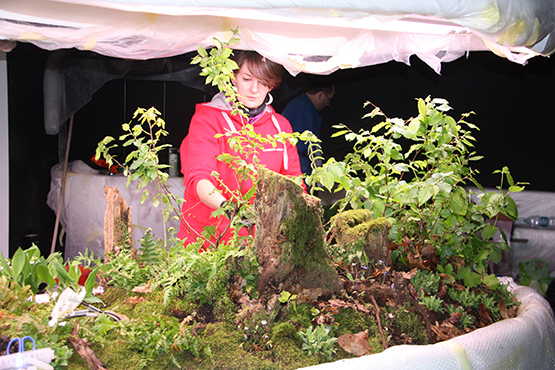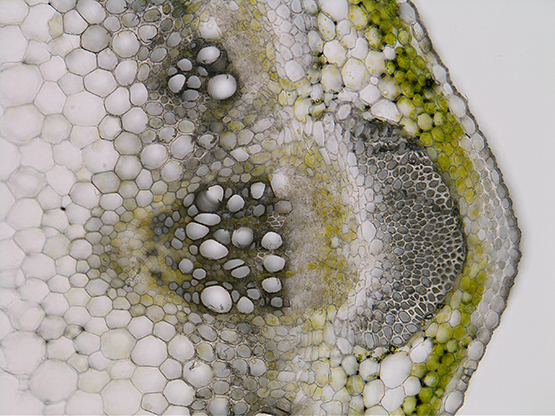The Czech forest in Milan grew in our botanic garden
Lab of Silence, Laboratorium silencii. This is the name of the AV installation project for the Czech pavilion at EXPO 2015, taking place in Milan, Italy, May 1 to October 31. The exhibits were taken to Milan just a few days ago, and the staff of our university, among many others, took part in the preparation.

The main feature of the Lab of Silence exhibition at the Milan EXPO is the Czech forest, including the herbaceous layer. The plants were pre-planted in the Botanic Garden of the Faculty of Science, Charles University. Photo by Mária Júdová.
The visitors of EXPO usually expect the reflection of the current technological development, based on constant acceleration and miniaturization. The Czech pavilion, and especially the Lab of Silence project, is something entirely different, at least at first sight. Its purpose is to show the nature, not technology. The main motto of the exhibition is “the slower we walk through the countryside, the bigger secrets are revealed to us.”
But the technology is a powerful ally when it comes to displaying nature in an efficient and impressive way. “The whole installation is very complex. It features, for example, 12 square meters of a living forest, automatic planting system, live streaming of the footage captured by miniscule cameras and projected on a huge screen, augmented reality functions, robotic arms or microscopes. The objective is to achieve as simple message as possible and a strong emotional experience,” said the senior project manager Jan K. Rolník of Full Capacity, the company realizing the project. A complex and interactive viewing experience is, after all, in line with the traditional Czech approach to global exhibitions.

The preparation of the Czech exhibition in Milan. Photo by Ladislav Pavlata
So what does this viewing experience offer? “The forest” will be captured by moving cameras, and the footage will be streamed right to the computer monitors. It will also include augmented reality functions, providing the visitors with additional information on what they can see. And why “Lab of Silence”? Because silence, peace and quiet play a major role in the exhibition, just as they do during the walk in a real forest. “The whole complex technological system will only start when the visitor is really relaxed and quiet,” says the author of the concept, Dávid Sivý from the Faculty of Architecture, Czech Technical University. “The interactivity of the exhibition is therefore based on non-activity or the contemplative approach of the visitor. This makes our exhibition very different to others, mostly full of light and noise,” added the author.

The view to the cellular composition of plant tissues is offered by the microphotographs taken by Aleš Soukup from the department of experimental plant biology at our faculty. Photo by Aleš Soukup
As the exhibition is mainly based on nature and the forest, its link to our faculty is really “organic”, in all meanings of this word. The Czech forest is represented by Hercynian oak and hornbeam wood – the biotope that may be considered a typical Czech Holocene forest. This type of vegetation is still pretty common, for example, around Prague (Český kras, Křivoklát area), in the České Středohoří mountains, at the foothills of Orlické mountains, or in Železné mountains. “In addition to oak and hornbeam, typical trees are hazel, linden and hawthorn. Typical representatives of the herbaceous layer are male fern (Dryopteris filix mas), gramineous plants (meadow grass), peas, anemones, veronicas, forget-me-nots or strawberries,” said Ladislav Pavlata, director of the Botanic Garden of the Faculty of Science, Charles University. In was in the glasshouses of this garden where the plants for the Milan exhibition were pre-planted. “During the visiting hours, the plants are exposed to the limited light mode. The full illumination, necessary for the proper growth of the plants, will be on at nights,” explained Pavlata.
However, the participation of experts from our faculty isn’t limited to the pre-planting in the glasshouses, which is part of the preparation of the plants for the special regime during the exhibition. “The idea to present nature in the first place really got to me, as a natural scientist. When I saw the report on the preparations of the exhibition on TV, I contacted the authors of the concept, Dávid Sivý and Jan Tůma, to offer them my participation,” said Aleš Soukup, Ph.D., from the department of experimental plant biology at our faculty, on how he joined the Lab of Silence.
“My contribution is the supply of the visual material for the highest degree of interaction, i.e. the view on the cellular level. The authors of the concept wanted the subjects to be captured in the original color scheme, without additional colorization or fluorescence, yet in motion, which was quite a challenge. The result – the living tissue shots – will be displayed on the 2 x 6 m screen.” According to Aleš Soukup, the visitor can silently watch and admire the dynamics of the plant at the cellular level, yet the plant seems to be static at first sight.
By Michal Andrle
The project team:
Jan K Rolník – senior project manager
Dávid Sivý – concept, author management
Jan Tůma, Jindřich Ráftl (R/FRM Studio) – architecture, design, author management
Martina Rubačová, Pavlína Dvořáková – expert botanic management
Andrej Boleslavský, Jakub Hybler – expert technological management and realization
Petr Patočka, Marek Winkler, Barbora Mitošinková – administration, production, PR
Cooperators:
Faculty of Architecture, Czech Technical University – Studio of Marian Karel, Studio of Vladimír Soukenka
Faculty of Electrical Engineering, Czech Technical University
UCEEB (University Centre for Energy Efficient Buildings), Czech Technical University